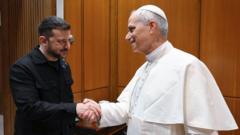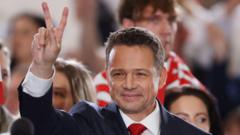The papal conclave, the first in over a decade, has begun under the dramatic frescoed ceiling of the Sistine Chapel, as cardinals face pressing issues like internal divisions and ongoing sexual abuse scandals.
**Cardinals Commence Historic Conclave to Elect New Pope Amid Church Challenges**

**Cardinals Commence Historic Conclave to Elect New Pope Amid Church Challenges**
In a solemn gathering, 133 cardinals initiated the conclave process, aiming to select the next leader of the Catholic Church following the death of Pope Francis.
As the doors to the Sistine Chapel closed, a historic moment unfolded with 133 red-robed cardinals entering to select a successor to Pope Francis, whose passing just weeks earlier prompted this crucial event. This unprecedented number of voting cardinals will engage in a secretive election process, grappling with the church's significant financial and moral challenges. Today's focus is not only on selecting a new pope but also reflecting on Francis's legacy of inclusiveness contrasted with conservative factions pushing for traditional values.
Before the conclave commenced, there was a final Mass at St. Peter's Basilica, setting a tone of unity and reflection among the cardinals. Secret voting protocols were outlined, emphasizing confidentiality and commitment to the church's future. Predictions are rife as cardinal appointees, some unfamiliar with one another, could lead to unpredictable voting outcomes. The evolving political landscape within the church is palpable as factions of progressive and conservative cardinals vie to outline its future direction.
With the first round of voting initiated, cardinals may not achieve a consensus today; they are expected to continue their deliberations and voting in the days to come, meticulously adhering to long-standing conclave rules. The potential impact of this conclave is significant as the Catholic Church seeks guidance through turbulent times, with many eyes on the chimney of the Sistine Chapel for signs of the next pontiff.
Before the conclave commenced, there was a final Mass at St. Peter's Basilica, setting a tone of unity and reflection among the cardinals. Secret voting protocols were outlined, emphasizing confidentiality and commitment to the church's future. Predictions are rife as cardinal appointees, some unfamiliar with one another, could lead to unpredictable voting outcomes. The evolving political landscape within the church is palpable as factions of progressive and conservative cardinals vie to outline its future direction.
With the first round of voting initiated, cardinals may not achieve a consensus today; they are expected to continue their deliberations and voting in the days to come, meticulously adhering to long-standing conclave rules. The potential impact of this conclave is significant as the Catholic Church seeks guidance through turbulent times, with many eyes on the chimney of the Sistine Chapel for signs of the next pontiff.




















